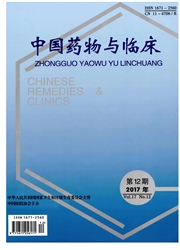

 中文摘要:
中文摘要:
目的建立液压创伤性脑损伤(TBI)模型,探讨创伤性脑损伤大鼠P物质(SP)和降钙素基因相关肽(CGRP)变化及其意义。方法健康雄性Wistar大鼠168只,体质量250—300g,随机分为损伤组(126只)及对照组(42只)。损伤组随机分为:轻度、中度、重度3组,每组42只大鼠。3种损伤组及对照组,分别再随机分为0.5、2、6、12、24、48、72h各7个亚组,每亚组6只。采用液压颅脑损伤仪,对轻度、中度、重度组分别给予0.5—1.0atm、1.5—2.0atm、2.5—3.0atm液压冲击力,制成轻、中、重3型液压颅脑损伤模型。分别于致伤后相应观察时间点对损伤组及对照组行心脏采血。采用酶联免疫吸附测定(ELISA)法测定血浆SP、CGRP的含量。结果创伤性脑损伤(TBI)中SP与CGRP血浆含量变化呈正相关(r=0.879,P〈0.01)。变化规律基本都是损伤后立即升高,随之迅速下降,12h或24h之后缓慢回升。不同程度TBI组及对照组之间SP、CGRP血浆总含量不同,差异有统计学意义(P〈0.01)。TBI中相同程度不同时间点之间SP、CGRP血浆含量不同,差异有统计学意义(P〈0.01)。TBI中损伤程度和时间对于SP、CGRP血浆含量有交互效应。SP血浆含量中度组0.5h时最高,重度组24h时最低。CGRP血浆含量中度组2h时最高,重度组24h时最低。结论TBI中SP与CGRP在血浆含量变化呈正相关,且与损伤程度有关,通过测定SP及CGRP血浆含量可以间接推测TBI病变及损伤程度。
 英文摘要:
英文摘要:
Objective To explore the profiles of substance P (SP) and calcitonin gene-related peptide (CGRP) and their significance in rat models of traumatic brain injury (TBI). Methods 168 healthy male Wistar rats (250-300 g in weight) were randomized into the injury (n=126) and control groups (n=42). The injury group was further divided randomly into 3 secondary groups based on severity of injury (mild, moderate and severe, n=42 each). These injurygraded groups and control group were again stratified into 7 sub-groups according to time from TBI (0.5, 2, 6, 12, 24, 48 and 72 h), such that every sub-group had 6 rats. To create TBI models, the rats assigned to injury group received different powers of hydraulic impact (0.5~1.0 atm, 1.5~2.0 atm or 2.5~3.0 atm depending on pre-specified severity of injury) delivered by a hydraulic brain hammer. Immediately after the injury and at specific time spots, cardiac blood samples were collected from each rat. The plasma levels of SP and CGRP were measured with ELISA. Results There was a positive correlation between post-TBI plasma levels of SP and CGRP (correlation coefficient: r=0.879, P〈0.01). The changes in plasma SP and CGRP were very similar in injury group, basically featured by a sudden rise after trauma, a quick decline that ensued, and then a gradual increase after 12 h or 24 h. However, the plasma levels of SP and CGRP varied significantly across all groups with different severity of TBI (P〈0.01) and time from injury (P〈0.01). Severity-time interaction was shown to have an effect on plasma levels of SP and CGRP. The peak and trough SP levels were recorded in 0.5 h-moderate and 24 h-severe sub-groups, and those of CGRP were recorded in 2 h-moderate and 24 h-severe sub-groups, respectively. Conclusion In traumatic brain injury, both plasma levels of SP and CGRP changed regularly to the degree of injury, with a positive correlation between each other. Detection of plasma SP and CGRP should be helpful to estimate the
 同期刊论文项目
同期刊论文项目
 同项目期刊论文
同项目期刊论文
 期刊信息
期刊信息
